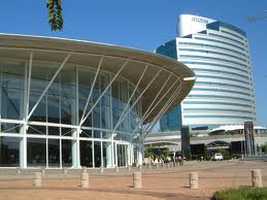Quick Facts: Durban CBD
- The Golden Mile (Marine Parade)
- Mini Town - a model city with replicas of Durban’s best-known buildings
- The Snake Park
- Waterworld is a large complex with waterslides and other amusements.
- UShaka Marine World
- Natal Bay and Victoria Embankment
- Vasco da Gama Clock
- Beautiful restored buildings and museums such as the Durban City Hall which wasbuilt in 1910 and modeled after that of Belfast, in Northern Ireland
- Playhouse: A mock Tudor facade
- Durban Natural Science Museum
- Durban Local History Museum
- Durban Art Gallery
- Old Train Station (Tourist Junction
- The Workshop: shopping centre housed in a vast, steel-girded Victorian building that was once the railway workshop
- Old Fort
- Old House Museum
- Victoria Street Market
- Juma Musjid Mosque
- Alayam Hindu Temple
- Durban Botanic Gardens
- Mitchell Park
- Campbell Collections
- Temple of Understanding
- Umgeni River Bird Park
- The Cable car at the new Soccer Stadium gives one a magnificent view of Durban
Distance to Airport: 41 km
Distance to City: 1 km
Introducing Durban CBD
The South African coastal city of Durban in the KwaZulu-Natal province is known as the mecca for holiday-makers. It is a large city with a subtropical climate and its port plays a major role in the South African ecomomy and trading. Durban has a superb beach front with its sandy beaches and warm currents of the Indian Ocean.
It is perfectly situated for exploring the scenic and varied coastline, to the South as far as Port Edward and to the North to the St Lucia Wetland and up to Kosi Bay. Many game and nature reserves are within easy reach as well as the awesome rugged escarpment of the Drakensberg. Durban is home to the largest concentration of people of Indian descent, who arrived in 1860, brought in as contract labourers to work on the sugar plantations, and many beautiful mosques and richly decorated temples can be seen. Durban produces most of South Africa’s sugar. Furthermore, it has the largest and busiest harbour.
In 1497, on Christmas day, Vasco da Gama is said to have anchored in the bay and named it “Rio de Natal”, the Christmas River. Later on sailors’ maps, the name “Natal” was given to the land that lay beyond the wide beaches and forested dunes along the coast.
In 1835 the small town with a mission station was renamed D’Urban after the governor of the Cape Colony. The former trading post is, today, the holiday capital of KwaZulu-Natal.


.jpg)
.jpg)
.jpg)

.jpg)
.jpg)
.jpg)